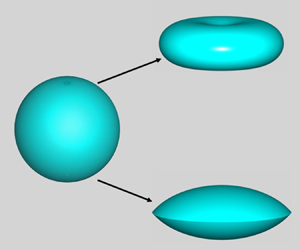Crossref Citations
This article has been cited by the following publications. This list is generated based on data provided by
Crossref.
Mawet, S.
Caps, H.
and
Dorbolo, S.
2021.
Deformation of soap bubbles in uniform electric fields.
Physical Review Fluids,
Vol. 6,
Issue. 4,
Marin, A.
2021.
The Saturnian droplet.
Journal of Fluid Mechanics,
Vol. 908,
Issue. ,
Wagoner, Brayden W.
Vlahovska, Petia M.
Harris, Michael T.
and
Basaran, Osman A.
2021.
Electrohydrodynamics of lenticular drops and equatorial streaming.
Journal of Fluid Mechanics,
Vol. 925,
Issue. ,
Raju, Geet
Kyriakopoulos, Nikos
and
Timonen, Jaakko V. I.
2021.
Diversity of non-equilibrium patterns and emergence of activity in confined electrohydrodynamically driven liquids.
Science Advances,
Vol. 7,
Issue. 38,
Sorgentone, Chiara
Kach, Jeremy I.
Khair, Aditya S.
Walker, Lynn M.
and
Vlahovska, Petia M.
2021.
Numerical and asymptotic analysis of the three-dimensional electrohydrodynamic interactions of drop pairs.
Journal of Fluid Mechanics,
Vol. 914,
Issue. ,
Kach, Jeremy I.
Walker, Lynn M.
and
Khair, Aditya S.
2022.
Prediction and measurement of leaky dielectric drop interactions.
Physical Review Fluids,
Vol. 7,
Issue. 1,
Behera, Nalinikanta
and
Chakraborty, Suman
2022.
Electrically modulated relaxation dynamics of pre-stretched droplets post switched-off uniaxial extensional flow.
Soft Matter,
Vol. 18,
Issue. 19,
p.
3678.
Khobaib, Khobaib
Rozynek, Zbigniew
and
Hornowski, Tomasz
2022.
Mechanical properties of particle-covered droplets probed by nonuniform electric field.
Journal of Molecular Liquids,
Vol. 354,
Issue. ,
p.
118834.
Tian, Yu
Liu, Yanchu
Peng, Zihan
Xu, Chenghao
Ye, Dong
Guan, Yin
Zhou, Xinping
Deng, Weiwei
and
Huang, YongAn
2022.
Air entrapment of a neutral drop impacting onto a flat solid surface in electric fields.
Journal of Fluid Mechanics,
Vol. 946,
Issue. ,
Firouznia, Mohammadhossein
Miksis, Michael J.
Vlahovska, Petia M.
and
Saintillan, David
2022.
Instability of a planar fluid interface under a tangential electric field in a stagnation point flow.
Journal of Fluid Mechanics,
Vol. 931,
Issue. ,
Anthony, Christopher R.
Wee, Hansol
Garg, Vishrut
Thete, Sumeet S.
Kamat, Pritish M.
Wagoner, Brayden W.
Wilkes, Edward D.
Notz, Patrick K.
Chen, Alvin U.
Suryo, Ronald
Sambath, Krishnaraj
Panditaratne, Jayanta C.
Liao, Ying-Chih
and
Basaran, Osman A.
2023.
Sharp Interface Methods for Simulation and Analysis of Free Surface Flows with Singularities: Breakup and Coalescence.
Annual Review of Fluid Mechanics,
Vol. 55,
Issue. 1,
p.
707.
Behera, Nalinikanta
Poddar, Antarip
and
Chakraborty, Suman
2023.
Eccentricity-induced dielectrophoretic migration of a compound drop in a uniform external electric field.
Journal of Fluid Mechanics,
Vol. 963,
Issue. ,
Thiruvenkadam, Natarajan
Patra, Pijush
Puttanna, Vishwanath Kadaba
and
Roy, Anubhab
2023.
Pair trajectories of uncharged conducting spheres in an electric field.
Physics of Fluids,
Vol. 35,
Issue. 3,
Wang, Geng
Lei, Timan
Yang, Junyu
Fei, Linlin
Chen, Jin
and
Luo, Kai H.
2024.
Lattice Boltzmann modelling and study of droplet equatorial streaming in an electric field.
Journal of Fluid Mechanics,
Vol. 988,
Issue. ,
Bigio, David I.
and
Sangli, Aditya N.
2024.
A new measure for drop deformation in extensional flows at low Reynolds number.
Physics of Fluids,
Vol. 36,
Issue. 2,
Peng, Gunnar G.
Brandão, Rodolfo
Yariv, Ehud
and
Schnitzer, Ory
2024.
Equatorial blowup and polar caps in drop electrohydrodynamics.
Physical Review Fluids,
Vol. 9,
Issue. 8,
Li, Fang
Yin, Xieyuan
and
Yin, Xiezhen
2024.
Equilibrium deformation of a transversely electrified, poorly conducting liquid column.
Physics of Fluids,
Vol. 36,
Issue. 9,
